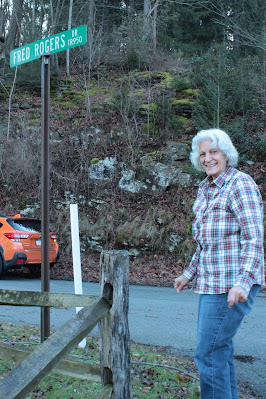Frank and I hadn’t been out on the road for a while due to doctors’ visits and other appointments and obligations, so this past Monday was picked as “the day”, come rain or shine. Well, the shine never appeared but the two of us managed to be on the road well before it was scheduled to show up.
We were past Butler before we started to see the trees against the morning sky. I always enjoy this time of day, whether I am sitting in my backyard, looking out the window or speeding across the countryside in a car. We didn’t see a sunrise, but it did get brighter.
A fine snow was coming down, just enough to haze the windshield and keep the roads wet. The approaching headlights glared off the road surface. I was glad when daylight arrived and that I had filled the windshield wash reservoir.
Naturally, there were a few geocaches we picked up along the way. The first one required a flashlight to see where it was hidden. We tend to feel a little bit more skilled (?) when we can find them in the dark!
We stopped a few times to take pictures; this was one of the purposes of these trips, along with spending some time with a good friend. Another purpose of this trip was to locate another old iron furnace. We were looking for the Stapley Furnace, sometimes called the Shippen Furnace. It was built in Venango County a little bit north of Emlenton. I had driven past it many times but never knew it was there. Once I learned about it, I had to see if I could find it. We had no idea what we would find.
The snow did add a bit to the scenery, covering just the tops of the homes and barns, giving everything a “frosted” look. The light snow also added a bit of fog to the view, adding a bit of mystery or the unknown to the area.
We visited a graveyard before we reached the furnace. It sat on a hill across the road from a small white chapel. Its’ steeple poked up over the trees reminding us of where the cemetery entrance was, the way back out. A cache was hidden here, inside a stump halfway down the hill, the chill of the weather soaked right through us and we were glad to return to the heat of the car.
The ruins of the Stapley Furnace are located near the top of a hill, unlike so many other furnaces which are often located beside or near a stream, in a valley. This furnace had bellows which were steam powered as compared to those that used the streams to turn a waterwheel to power the bellows.
Entering the woods, we passed the foundations of an old barn. Looking at the stones I got the idea that they may have come from the furnace. They were large and cut into rectangular shapes, they weren’t regular field stone.
A slight trail led down the hill past the barn, we passed a couple more stone walls and foundations on the way. I wondered if they had been built at the same time as the furnace or later. The path was a bit muddy, the snow made it slippery and we had to be careful about our footing.
When I first saw the furnace, I thought it looked like just a pile of stones but looking further, I could see some brickwork near the top, curved like a chimney. All of the outer coverings were gone. (perhaps the foundations that we passed above?) This furnace was built in 1835 by Charles and Richard Shippen. When it was operating it produced 1000 tons of iron a year. I couldn’t find out when it went out of blast.
Like so many furnaces hidden in the woods, it wasn’t easy to get close to. There was an abundance of vines, broken limbs and jagger bushes around it, almost as if they were protecting it. My tripod was continuously getting caught. I had to fight the vines and thorns and I had to be careful where I was putting my feet, the base of the furnace seemed to be all loose stones, covered with snow. A nice stone wall sat behind the furnace, against the hillside. This might have been the base of the charging bridge. I did see a few animal trails going in-between the stones, so in some ways, the furnace was still being used.
Standing in amongst the stones and walls, I tried to imagine what this place had been like back when the furnace was in operation. It would’ve been smoky and noisy; the men would have to yell to be heard. The sounds of industry would be covering over any birds that might be chirping. Instead of the trees and bushes there would have been buildings and roads. I tried to imagine it but all I heard was silence, that and the occasional sound of a car rushing by. The drivers nice and warm in their cars, never realizing what once was sitting here or what still lingers behind, hidden in the woods.
The Stapley Furnace, gone but not forgotten, at least by a few of us!






















.jpg)











